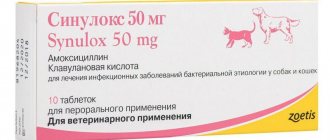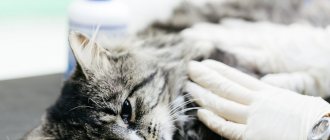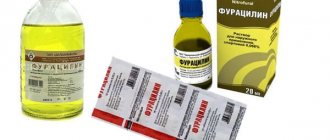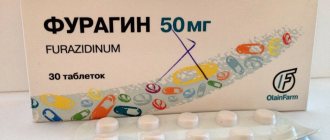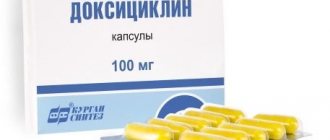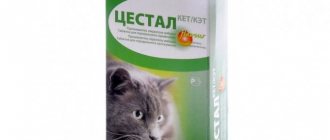Classification of antibiotics. Release forms
You shouldn’t try to remember all the possible commercial names of drugs that cats can use. It is always enough to ask which antibiotic or active substance is included in the antimicrobial drug.
According to their action, antibiotics are divided into:
- bacteriostatics (inhibit the ability of bacteria to reproduce and develop);
- bactericidal (kill pathogens).
According to the active substance:
- penicillins:
- cephalosporins:
- aminoglycosides:
- fluoroquinolones:
- nitrofurans:
- chloramphenicol:
- lincosamides:
- tetracyclines:
- macrolides:
- sulfonamides:
- glycopeptides:
- polymyxins:
- carbapenems:
According to the spectrum of action:
- wide spectrum;
- highly specific.
By method of administration to the body (how to give an antibiotic to a cat):
- oral (in the mouth);
- injection (in the form of injections);
- local (powders, ointments, gels, etc.).
By origin:
- natural (true) - chemical substances produced by some microorganisms to combat others;
- synthetic – artificially created antimicrobial agents.
The principle of action does not depend on the form of release of the medicine, the only question is the convenience of administration - for some it is convenient to inject, for others it is convenient to give the cat an antibiotic in tablets.
Problems and Cautions
Pseudomonas infections are especially common in canine ear infections and, if not controlled decisively, can become persistent. Higher doses of fluoroquinolones are required to kill this bacterium and are associated with significant costs. It is tempting to use ciprofloxacin because an inexpensive generic is available, but if bioavailability is poor and the infection becomes prevalent, it will become even more difficult to treat. In other words, it may not be worth the risk of using inexpensive drugs, and the use of ciprofloxacin in this situation should be carefully weighed against the monetary savings.
Ciprofloxacin should not be used in pregnant or lactating cats or immature dogs unless the severity of the infection justifies its use.
^Top
Advantages and disadvantages of antibiotic therapy in cats
The main advantages include:
- reduction of treatment time for the disease, ease of administration, low effective dosages (some antibiotics are used in short courses with a single injection due to their action);
- rapid improvement in the pet’s condition;
- the presence of broad-spectrum properties (when there is no time or opportunity to determine the sensitivity of a microorganism to a particular narrowly acting antibiotic);
- reducing the risk of complications from the underlying disease;
- high efficiency even with a high concentration of bacteria in the body.
The disadvantages of taking antibiotics are:
- with long-term antibiotic therapy, the body's overall resistance to infections decreases;
- long courses can cause microorganisms to become accustomed to the drug and reduce its effectiveness;
- violation of the dosage leads to serious consequences and complications (in particular, if it is exceeded);
- Sometimes it is additionally necessary to take medications that normalize the microflora of the gastrointestinal tract.
It is important to note that all the disadvantages and side effects of antibiotics are minimized with the correct selection of their names and accurate dosage calculations.
Side effects
As with most oral medications, the most common side effects of ciprofloxacin in cats are gastrointestinal:
- vomit
- diarrhea
- loss of appetite
- salivation
In immature dogs (under 8 months of age), damage to developing articular cartilage may occur. This phenomenon occurs only in growing dogs and does not appear to be a problem in cats. It is preferable not to use this drug in puppies unless the severity of the infection present warrants it.
Enrofloxacin, the first veterinary fluoroquinolone, was found to cause retinal damage and blindness when used at higher doses in cats. This occurs because feline retinas tend to accumulate enrofloxacin. Because ciprofloxacin is converted to enrofloxacin at higher ciprofloxacin dosage regimens
, are generally needed to overcome bioavailability issues, which may not be the best antibiotic choice for cats. However, ciprofloxacin tends not to accumulate in the feline retina, and vision problems have not been reported with ciprofloxacin therapy.
Fluoroquinolone antibiotics may lower the seizure threshold and increase a cat's susceptibility to seizures. This is of no significance in a normal animal, but is worth a caution in patients with a pre-existing seizure.
Ciprofloxacin is known to form crystals in urine and form actual bladder stones in humans. Cats taking ciprofloxacin should be kept hydrated to avoid any problems with stone formation.
Which antibiotic to choose? Classification by groups
Cat owners must learn the most important rule - only a veterinarian can select antibiotics! Not everyone can inject a cat with antibiotics, because... Not all antibiotics are acceptable for use in cats, not all have analogues in human medicine and can be replaced with some other drug.
If the doctor has no doubt about the diagnosis, then it is best to focus on narrowly acting drugs. If the condition is complicated by secondary infections or there is no time to isolate the pathogen, a broad-spectrum antibiotic certainly comes to the rescue.
Doses of antibiotics are prescribed only by a specialist, based on the specific case of the disease. All information provided is for informational purposes only!
Penicillins
prescribed for purulent wounds, burns and various types of inflammation of dermal origin (bacterial skin pathologies). In some cases, they are prescribed for pathologies of the urinary system.
| Dosage and methods of antibiotic administration | Notes |
| Benzylpenicillin (potassium or sodium), this is (Intramycin, Multipen, Penbex, Pen-Strep) 20-40 thousand units/kg IM or IV every 4-8 hours. The course is determined by a veterinarian. | The main side effect is allergies after the 2-3rd injection (itching, urticaria, rarely anaphylactic shock). In case of an individual reaction to any of the penicillins, it is prohibited to use other drugs in this group. |
| Ampicillin (Albipen LA) 10-20 mg/kg by any route of administration every 6-8 hours. The duration of the course is determined by the type and complexity of the infection. | |
| Amoxiclav (Amoxiclav, Sinulox, Amoxigard, Xiclav) per os twice a day at a rate of 12.5 mg/kg for 5-10 days. | |
| Amoxicillin (Amoxisan, Amoximag, Amoxilong 150, Amuril, Amoxoil Retard, Vetrimoxin LA, Amoxan, Amoxivet) orally at a dose of 10 mg/kg every 8-12 hours, if intramuscularly, then 7 mg/kg once a day or 15 mg/kg once every 48 hours (for long-acting drugs) |
Cephalosporins
broad-spectrum antibiotics, divided into several generations according to their origin and characteristics of action. Suitable for almost any infection, when there is no time to wait for a bacterial sensitivity test or when therapeutic measures need to be applied as soon as possible. Infections of the gastrointestinal tract, genitourinary system, breathing and sometimes vision can be treated. Therapy for sepsis responds well.
| Dosage and methods of antibiotic administration | Notes |
| Ceftriaxone (Ceftrivet) IM, IV once a day, 50 mg/kg or every 12 hours, 20-25 mg/kg. | Very painful with intramuscular injection! Often prescribed after sterilization surgery due to its spectrum of action. |
| Cefazolin 20-35 mg/kg IV or IM 2-4 times a day at regular intervals. | Not prescribed for renal pathologies. Some representatives can be addictive, which leads to the further choice of a stronger antibiotic for treatment. |
| Cephalexin (Mastileks, Cephalen) IM, orally or subcutaneously 10-25 mg/kg once a day. | |
| Ceftazidime (Fortoferin) From 20 to 50 mg/kg every 8-12 hours in a course determined by a specialist. | |
| Cefotaxime (Clafobrine) SC, IV or IM at a dose of 20-40 mg/kg. |
Aminoglycosides
They cope well with colds, the onset of peritonitis, and pneumonia. May help with soft tissue infections. A very toxic group, prescribed in particularly difficult cases.
| Dosage and methods of antibiotic administration | Notes |
| Kanamycin IM or SC 2-3 times a day for a week at a dose of 0.1 ml/kg (25 mg/kg). | Rarely, allergic reactions may occur. If the dosage and duration of administration are observed, there are no side effects. In case of overdose, the kidneys and vestibular apparatus are affected. |
| Amikacin s/c, i/m, sometimes intravenously 5-10 mg/kg 2 times/day. at regular intervals or every 8 or 24 hours. | It is not allowed in case of urolithiasis and severe kidney pathologies. |
| Gentamicin (Gentam, Gentaprim, Gentavet) Twice a day and no longer than 5 days at a daily dose of 2-5-8 mg/kg IM. It is possible intravenously, but very, very slowly along with a drip. | Not for severely weakened individuals, old people or those with kidney pathologies. If used incorrectly, it can cause hearing damage. |
| Streptomycin (Streptovik) IM 10-50 mg/kg twice or thrice a day at equal intervals. The course of treatment is 4-7 days. | In cats it is used for active leptospirosis and carrier status. |
| Neomycin per os 10-20 mg/kg daily or 2.6 mg/ml diluted with drinking water. | Least toxic of all aminoglycosides. |
completely synthetic antimicrobial substances that have a broad spectrum of action on most bacteria. They are used most often for genitourinary infections, because do not burden diseased kidneys. Some of them can help with bacterial skin pathologies.
| Dosage and methods of antibiotic administration | Notes |
| Ciprofloxacin (Tsiprovet, Cipromag) Orally 5-15 mg/kg twice a day for 5-14 days | The only adverse reactions are individual intolerance. |
| Levofloxacin (Lexoflon, Lexoflon OR, Ornitil, Endolex) Per os once a day 10 mg/kg or twice a day 5 mg/kg. Course 5-10 days. | |
| Enrofloxacin (Baytril, Enroflox, Coliflox, Ribaflox, Enroxil, Enromag, Enronit, Enroflon, Renrovet, Kolmik E) Once a day per os or subcutaneously at a dosage of 5 mg/kg for a course of 3-5 days. Can be divided into double doses every 12 hours, 2.5 mg/kg. You can use the drinking version (oral enrofloxacin) in the same dosage, after mixing it with water or milk. | Not for young animals with unformed cartilage tissue. It is forbidden to overdose - it provokes eye pathologies (retinal degeneration). Cats are administered only subcutaneously! The solution has a very bitter taste, which causes severe salivation. |
cope well with skin infections, bedsores and skin ulcers, corneal injuries, gastrointestinal pathologies, mastitis. Along with fluoroquinolones, urinary tract infections are well treated. Some representatives of the group are actively used for intestinal bacterial infections (salmonellosis, colibacillosis, enteritis, enterocolitis, etc.).
| Dosage and methods of antibiotic administration | Notes |
| Furagin 5-10 mg/kg every 8 hours for at least 5 days, maximum prescribed by a veterinarian. | Do not use in case of renal failure, pregnancy, or if you have ever had a reaction to nitrofurans. Your cat's urine may become darker in color. |
| Nitrofurantoin The daily dose is 5-10 mg/kg, given in 2-4 doses per day. The course of application is no more than 7 days. It works well for purulent cystitis. | Cannot be used if there is a general intolerance to nitrofurans, as well as in animals with pathologies of the kidneys, heart and liver. With prolonged and uncontrolled use, the composition of the blood changes, nausea, vomiting and persistent diarrhea appear. |
| Nifuroxazide (Nifurovet) Per os 100 mg/animal for 1 dose in capsules or as a suspension. Kittens are given 20 mg per dose. Frequency: 2-3 times a day for 2-7 days (on average, stop giving the drug if there has been no diarrhea in the last 12 hours). Give your cat plenty of water to drink. | Most often used for intestinal infections. Can be used on pregnant cats. It has no side effects with the correct dose and course. |
| Furazolidone Per os at the rate of 4 mg/kg every 12 hours for no longer than 7-10 days. | The color of urine changes from dark yellow to brown. There are frequent cases of toxic liver damage and severe allergic reactions with overdose and use for longer than possible. |
have a wide spectrum of antimicrobial action and can affect intracellular parasites. Penetrates well into the liver, kidneys, spleen and lungs. An excellent choice for intestinal infections. It should not be used for a long time; there is a high risk of causing dysbacteriosis.
| Dosage and methods of antibiotic administration | Notes |
| chloramphenicol (synthetic) chloramphenicol (natural analogue) (Levanzam, Levotetrasulfin, Lenovit, Fenicol, Chronitsin, Floricol) 10-20 mg/kg per os 2-3 times a day for a course of 3-7 days, depending on the disease. The solution is dripped locally into the eyes, 1-2 drops in each eye. The frequency depends on the concentration of the drug. | Very bitter! After giving it inside, there is strong salivation. In cats, side effects are most common, so it is prescribed quite rarely. |
any infections of the skin, abdominal cavity, genitals, as well as pathologies of the respiratory tract.
| Dosage and methods of antibiotic administration | Notes |
| Lincomycin (Linkovic) Orally every 8 hours, 15 mg/kg or 22 mg/kg every 12 hours. Slowly IV, 11-22 mg/kg every 12 or 24 hours. IM twice a day, 11 mg/kg or once 22 mg/kg. | Works well for lung and bone infections. Incompatible with chloramphenicol. There are no side effects. |
| Clindamycin (Clindaspectin) SC or per os 10–15 mg/kg, every 12 hours. | Do not use in cats with liver and kidney pathologies. Do not combine with chloramphenicol, erythromycin and aminophylline. |
catarrhal and purulent conjunctivitis (especially chlamydia), endometritis, the initial stages of development of peritonitis, pneumonia, pleurisy, sometimes with infections of the genitourinary system. They work well in combination with penicillins.
| Dosage and methods of antibiotic administration | Notes |
| Doxycycline (Doxylox, Doximag, Ronaxan, Paudox, Doxatib) It is best to take 10 mg/kg orally once a day with food or 5 mg/kg twice with an interval of 12 hours. Duration of treatment is 8-10 days. | Only reactions of individual sensitivity are possible. It is better not to give doxycycline monohydrate orally as it causes side effects in cats such as nausea, vomiting, and decreased appetite. Ronaxan, doxatib and paudox (containing doxycycline in the form of hyclate) are best tolerated internally. All other drugs are best used by injection. |
| Tetracycline (Laucetin) Usually 10-20 mg/kg orally 3 times a day for 7-14 days. Sometimes longer therapy is required. 1-2 drops are dripped into the eyes for up to 3 weeks, if positive dynamics are noted. If not, the drug is discontinued. | Most often used for eye pathologies and chlamydia. Used as a test for viral conjunctivitis - if it does not work, then a virus is involved. |
one of the relatively safe groups of antibiotics. Most often used to suppress secondary infections of the respiratory tract and gastrointestinal tract. They have no effect at all on salmonella, fungi and viruses, and are most active against penicillin-resistant bacteria. In some cases, they may be prescribed to pregnant cats, because... do not pose a danger to the fruit.
| Dosage and methods of antibiotic administration | Notes |
| Erythromycin (Laucetin, Eridin) Orally 5-15 mg/kg every 12 or 8 hours. Duration is usually no more than 7 days (minimum 5). | Long-term uncontrolled use may cause problems with the liver. |
| Azithromycin (Azitronit, Zitrocox, Azikan) On the first day, take 5-10 mg/kg orally once, from the third day the interval between doses can be increased to 48 hours. The course is calculated by the veterinarian. | Do not use with heparin. The only side effects are flatulence. Works well for respiratory tract infections. |
| Tylosin (Macrolan, Tilovet, Tilomag, Farmazin, Frazidin, Tilar) 2-10 mg/kg IM once a day or 7-11 mg/kg orally every 6-8 hours. The course is usually 3-5 days. | It tastes very bitter and injections are sometimes painful. On days 5-6, painful bumps may appear at the injection site. |
bacteriostatics that are well suited for infections of the respiratory tract, genitourinary system, gastrointestinal tract, enteritis and some viral infections as suppressors of secondary infections. If necessary, they are prescribed in combination with bactericidal antibiotics for pyometra (purulent inflammation of the genital organs).
| Dosage and methods of antibiotic administration | Notes |
| Streptocide 0.3-2 g orally every 4-5 hours, starting with large doses. The duration can be up to 14 days. | In addition to internal infections, streptocide can be sprinkled on wounds. Internally to treat a sore throat, you can mix it with butter. |
| Biseptol Orally 40 mg/kg twice a day for 10-14 days. | Under certain conditions, you can inject a cat with fungal pneumonia. Bitter, it is better to give in the form of a suspension. Do not give if there are liver pathologies. |
| Phthalazole 0.1-0.2 g/kg for oral administration 1-3 times a day for 10 days. | Not given for pathologies of the kidneys and liver. Good for small kittens. |
a very strong group of natural antibiotics, rarely used to treat cats, because belongs to the reserve group. They are excreted unchanged by the kidneys, so they are not prescribed for pathologies. Mainly useful for the treatment of meningitis, infective endocarditis, severe sepsis, when the infections are severe and cannot be treated with other antimicrobial drugs.
| Dosage and methods of antibiotic administration | Notes |
| Vancomycin IV only - 12-15 mg/kg every 8 hours. The duration of administration is determined only by a veterinarian, depending on the complexity of the situation. | It is strictly forbidden for pregnant cats to take it if they need to get a healthy litter, and if they have chronic kidney pathology. May provoke hearing and kidney damage, tachycardia, thrombocytopenia. |
a very strong group of antibiotics, administered only by injection (parenterally) and for special protracted and multi-resistant infections, when conventional antibacterial agents do not cope.
| Dosage and methods of antibiotic administration | Notes |
| Imipenem 3-10 mg/kg with IV or IM administration. The duration of the course is determined by the veterinarian. | May change some blood parameters, allergic reactions and anaphylaxis are possible. |
| Meropenem 5-10 mg/kg by any injection methods. In special cases, the dosage can be increased to 24 mg/kg once a day when administered intravenously. |
a narrow group of agents that act on various types of fungi, including ringworm.
| Dosage and methods of antibiotic administration | Notes |
| Griseofulvin (Dermicocide) Very long-term (3-5 weeks) orally 10-30 mg/kg twice a day every 12 hours. | There may be diarrhea and urticaria due to individual sensitivity or overdose. Do not use with liver and heart problems. |
| Nystatin Orally from 20 to 750 thousand units/cat 2-4 times a day for 10 days, depending on the severity of the condition. | Copes perfectly with candidiasis of various localizations. Low toxic. |
| Levorin Orally from 20 to 750 thousand units/cat 2-4 times a day for 10 days, depending on the severity of the condition. | Cannot be used for liver pathologies. |
antimicrobial and antiprotozoal group of broad-spectrum substances. It is prescribed when the diagnosis is beyond doubt, and the benefits will definitely be higher than the harm from side effects.
| Dosage and methods of antibiotic administration | Notes |
| Metronidazole (Metronide, Stomorgyl, Trichovet, Ursometronide) Orally 10-20 mg/kg 1-2 times a day. When administered intravenously (with a concentration of 5 mg/ml), the consumption is 2-5 ml/kg of body weight, depending on the type of infection. The frequency is also 1-2 times a day. | Positively affects the overall immunity of the body. Allergic reactions and side effects on the kidneys are common. The maximum permissible high doses are taken for protozoal infections. |
Of course, this is not a complete list of those antibiotics that generally exist in groups and that are approved for cats, but only the most frequently encountered and used in veterinary practice. In total, about 25 types of antibiotics are used in veterinary medicine, but not all are acceptable for use in small animals.
Tsiprovet: composition, properties and release form of the drug
The production of 2 dosage forms of the human drug “Ciprofloxacin” has been established: tablets, injection solution. The blister consists of 10 pills in a round shell. The mass of one is 0.2 g, diameter is 8 mm. Each tablet contains 15 mg of ciprofloxacin hydrochloride. Supplements included:
- microcrystalline cellulose;
- potato and corn starch;
- talc;
- magnesium stearate;
- anhydrous colloidal silicon dioxide;
- titanium dioxide, etc.
The antibiotic can be found commercially packaged in bottles.
The drug "Ciprofloxacin" belongs to a group called fluoroquinolones, which have an antibacterial effect. Microorganisms die and protein synthesis is disrupted as a result of blocking the enzyme DNA gyrase, which, in turn, affects the replication of the DNA helix in the nucleus of the bacterial cell.
Refers to non-toxic substances. It affects microbes in a state of rest or reproduction. Available for purchase in a cardboard box with instructions for use. The solution is bottled in 100 ml glass bottles, sealed with rubber stoppers and aluminum caps. Externally it is an almost transparent yellowish liquid.
The active component of Ciprovet is ciprofloxacin hydrochloride, which is part of the fluoroquinolone group of antibiotics. The substance is known for its antibacterial, antiseptic and anti-inflammatory properties. Ciprofloxacin blocks the synthesis of bacterial DNA, due to which morphological changes occur in the cell wall, bacterial division stops, and they quickly die.
This drug is prescribed to combat diseases caused by Escherichia coli, Salmonella, Shigella, Pseudomonas aeruginosa, Pasteurella, Brucella, Toxoplasma, Streptococcus, etc. One of the advantages of the drug is the slow development of resistance to its active substance. Using this product, they fight bacterial infections that are resistant to penicillins, tetracyclines and cephalosporins.
Ciprovet is available in the form:
- Eye drops. They are a transparent pale yellow or colorless liquid. Available in containers of 5 and 10 ml. For ease of use, the bottle is equipped with a pipette.
- Tablets. They are yellow dragees, packed in blisters of 10 pieces each. When purchasing, you need to pay attention to the “about” and “for dogs” to avoid an overdose. In the first case, each tablet contains 15 mg of antibiotic, in the second - 50 mg.
- Solution for injection. Transparent yellow liquid. Injections are prescribed for severe infectious diseases when oral antibiotics do not give the desired effect, for example, bronchopneumonia and advanced salmonellosis.
One of the advantages of Ciprovet tablets is the absence of dysbacteriosis in cats after taking them due to the presence of lactulose in their composition. This synthetic prebiotic is resistant to enzymes in the upper gastrointestinal tract and reaches the large intestine unchanged. With the aggressive action of the antibiotic, which suppresses the proliferation of all microorganisms, lactulose stimulates the spread of its own microflora in the intestine and the formation of organic acids - acetic, butyric, lactic and propionic, which acidify the intestinal environment and increase the osmotic pressure in this area.
We suggest you familiarize yourself with How to care for aquatic turtles at home
When taking tablets, most of the ciprofloxacin is absorbed in the small intestine, then enters the bloodstream and spreads throughout the body, affecting areas affected by pathogenic flora.
Tsiprovet should be stored away from food, in a dark place at a temperature of no more than 25 degrees. Drops should never be placed in the refrigerator - cold destroys the structure of the liquid molecules, which is why it loses its therapeutic properties. The shelf life of the drug is 3–4 years (tablets).
Improvement is usually observed on days 3–5 of using the medication. If by this time the symptoms of the disease do not subside, you need to contact a specialist to change the medication regimen or replace it.
Eye drops
First of all, you need to wipe the cat’s eyes with a dry cotton pad, and then drop in 1 drop of medicine, trying to get under the eyelid and not touch the cornea. Next, you need to carefully cover your eyes with your finger so that the liquid is evenly distributed over the surface of the eyeball. In the case of a purulent complication, you first need to drop a few drops of the drug into the eyes, wait until the crusts soften, and remove them with a swab. Next, you need to re-drop 1-2 drops of the medicine.
It is best to apply drops into the eyes after eating, when the animal is calm and relaxed. The procedure is carried out 3-4 times a day for a week. In case of advanced and severe pathology, the frequency of use of drops is increased to 8 times a day, and the duration of treatment is up to 2 weeks. If several different drops are instilled into your cat at the same time, you need to take a break of 5–7 minutes between each use.
The dosage of the drug is determined based on the weight of the animal: 1 tablet per 3 full kg. The medication should be taken half an hour after meals. The medicine is best given whole, but it can also be crushed, mixed with a treat. Tablets are used once a day for 3–5 days. If there are complications, the veterinarian will extend the treatment period.
General tips for use
Self-medication is highly undesirable!
You should not prescribe antibiotics for cats yourself, especially if it is a purely human drug. All appointments are made only by a specialist and ideally after testing potential bacteria for sensitivity to a particular drug. In this case, the therapeutic effect will be most noticeable. If this is not possible, only a veterinarian should select a general antibiotic.
An antibiotic can be harmful if given inappropriately or in the wrong dosage
Antimicrobial drugs should be prescribed only in cases where it is obvious that they cannot be avoided. Compliance with dosages is important. Otherwise, taking antibiotics is a recipe for complications and super-infections, when microorganisms develop resistance and mutate, becoming stronger and causing infections that are difficult to treat.
Taking probiotics
It is rare, but it happens that after antibiotics a cat begins to suffer from indigestion due to dysbacteriosis, because the drug “kills” and is more beneficial for intestinal bacteria. Therefore, immediately after a course of antibiotic therapy, you should start taking probiotics - drugs with a concentration of beneficial intestinal microorganisms. This should not be done simultaneously with antimicrobial drugs, because they will continue to die from the drug.
A course of treatment
Each antibiotic comes with instructions that clearly state how many days the treatment should last. Under no circumstances should you shorten the treatment time with antibacterial agents on your own! Usually the course lasts at least 5 days, then, if necessary, it can be extended to 7, 10 and 14 days (unless otherwise indicated in the instructions).
There are long-acting antibiotics, when a course of a maximum of 3 days or even 1 injection/tablet for 5-7 days is sufficient. All these nuances are spelled out in the instructions.
If you shorten the duration of use, you can thus worsen the cat’s health and develop microorganisms’ addiction to the drug, which will be the reason to choose more complex and strong antibiotics for treatment in the future.
Antibiotics affect the reproductive system
The negative impact on the ability to reproduce can be reduced by taking a break between matings and the end of the course of antibiotic therapy. Typically, for at least 3-5 months, depending on the drug used, the cat cannot be mated to produce offspring. There are high risks of miscarriage or the appearance of an offspring with congenital anomalies. Some antibiotics, through their toxic effects, can have a negative effect on the primary formation of internal organs after fertilization and development of embryos.
Fungal diseases cannot be treated with antibiotics
Not everyone knows that some antibiotics are a breeding ground for stronger growth of fungi. The pet's condition will only worsen. To treat cats in this case, specialized antifungal agents or special antifungal antibiotics are used. In other cases, antibacterial agents are not used.
Analogues of the antibiotic "Ciprofloxacin"
"Tsiprovet" or "Tsiprolet"
Eye drops for cats are intended to combat ophthalmic diseases caused by infection. You can apply it to kittens and dogs, but not younger than a week old. Eye drops have virtually no contraindications. If the instructions are strictly followed, the kitten will not experience any side effects. The precedent happens extremely rarely, then a mild painful condition manifests itself, possibly burning and itching. Tsiprolet drops for cats are not given to pets suffering from cerebral atherosclerosis in case of cerebrovascular accident.
Strictly prohibited combinations of antibiotics
Not all antibiotics can be used at the same time. There are combinations that are strictly prohibited and can have serious consequences for your pet’s health!
Do not mix:
- Aminoglycosides and cephalosporins (the nephrotoxic effect increases, acute renal failure or nephritis develops).
- Nitrofurans and fluoroquinolones (full antagonists that cancel each other’s effects).
- Fluoroquinolones and cephalosporins (severe kidney damage (nephrotoxic effect), leukopenia).
- Sulfonamides and chloramphenicol (pharmacologically incompatible).
- Aminoglycosides, vancomycin, polymyxin with furosemide (a sharp increase in the toxic effect on the hearing organs until it is completely lost).
- Beta-lactam antibiotics and carbapenem (obvious antagonists).
- Cephalosporins (especially ceftriaxone) with calcium gluconate (especially in one syringe).
- Aminoglycosides (in particular gentamicin) and penicillin antibiotics cannot be mixed in the same syringe (antagonists, increasing the ototoxic properties of gentamicin). At the same time, combination therapy with different injections is welcome.
- Ceftriaxone and vikasol (complete neutralization of the effect of vikasol).
- Polymyxin, penicillin and cephalosporins (pharmacological incompatibility with each other).
Dose for cats
Baytril 2.5% or 5% injections subcutaneously or intramuscularly
2.5 - 5 mg/kg per day, 1 time per day.
Ciprofloxacin tablets
5 - 20 mg/kg per day, 1 time per day or dividing the daily dose into 2 doses.
Baytril 2.5% - Solution for injection
A broad-spectrum antimicrobial drug for the treatment of infectious diseases in dogs and cats.
It is quickly absorbed into the blood and penetrates well into all tissues and cells of the body.
Does not have an immunosuppressive effect.
Does not cause an allergic reaction.
Non-toxic, does not have mutagenic or teratogenic effects, and does not cause reproductive dysfunction.
It is excreted mainly in the urine and does not cause a nephrotoxic effect. The presence of pus and an acidic environment does not interfere with the action of the drug.
The concentration in the affected tissue is higher than in healthy tissue.
Compound:
1 ml of solution contains 25/50 mg of enrofloxacin as an active ingredient.
Indications for use: - Diseases of the respiratory system, gastrointestinal tract, genitourinary system, skin, septicemia, osteomyelitis caused by gram-positive and gram-negative bacteria (staphylococcus aureus, streptococcus ssp., Clostridium perfringens, e. Coli, salmonella ssp., Proteus sp. , Pasteurella multocida, pasteurella haemolytica, etc.) and mycoplasmas.
— As a prophylactic agent during operations and during the rehabilitation period after operations.
Dosage and method of administration: Recommended dose 5 mg per 1 kg of weight: Baytril 2.5% - 0.2 ml/kg.
The drug is administered subcutaneously, intramuscularly once a day. The course of treatment is on average 5 days.
Baytril is also used to treat exotic animals and birds.
Contraindications: Do not use before 12 months of age or until the end of the animal’s (dog’s) growth, with significant disturbances in the development of cartilage tissue, or damage to the nervous system.
Baytril should not be used if quinolone-resistant strains of pathogenic bacteria are detected.
Baytril should not be used simultaneously with macrolides, tetracycline, theophylline and non-steroidal anti-inflammatory drugs.
What antimicrobial drugs are used in cats?
- Use of Trichopolum for cats
- Instructions for use of ceftriaxone for cats. Examine the breadth of the antibacterial effect of ceftriaxone in cats. Calculate the optimal dose of the drug. Improve therapy effectiveness by 200%
- Instructions for use of Metrogyl for cats. Explore the breadth of Metrogyl's antibacterial effects. Calculate the optimal dose of the drug for cats. Improve the effectiveness of therapy by 2 times
- Use of the antibiotic doxycycline in cats
- Instructions for use of clindamycin for cats (Clindamycinum). Study the breadth of the antibacterial effect of clindamycin in cats. Calculate the optimal dose of the drug. Improve therapy effectiveness by 140%
- Instructions for use of metronidazole for cats (Metronidazole). Study the breadth of the antibacterial effect of metronidazole in cats. Calculate the optimal dose of the drug. Improve therapy effectiveness by 140%
- Doxifin for cats (instructions for use, doses, indications and contraindications)
- Atovaquone for cats
- Azithromycin (Azithromycin) for cats (instructions for use, doses, indications and contraindications)
General information about ciprofloxacin
When treating diseases of cats and dogs, veterinarians do not always resort to antibiotics. Chemotherapy drugs of this group are prescribed in the following cases:
- Infectious lesions of the ears and eyes;
- Purulent lesions and skin infection;
- Treatment of diseases of a bacteriological nature (cystitis, piloeniphritis, pneumonia, pyometra and others);
- Diseases caused by various microorganisms - chlamydia and intestinal infections. Tuberculosis and leptospirosis, salmonellosis and pseudomonosis, staphylococcosis, enterococcal infection.
© shutterstock
Ciprofloxacin has a number of benefits. If used correctly and strictly following the dosage, the drug is slightly toxic. Treatment with an antibiotic will proceed faster. Even when used in the smallest dosages, it is effective.
Ciprofloxacin has a broad spectrum of antimicrobial activity. During the life of microorganisms that enter the animal, they release toxins that are poisonous to the body. The drug easily neutralizes and removes them. During the treatment process, the substance, entering the environment of microorganisms, does not lose its antibacterial properties.
There are some negative aspects to the use of Ciprofloxacin, which every cat owner should be aware of when treating the animal.
If you use this antibiotic whenever you want, without following the instructions, your pet’s body will get used to it and there will be no effect from the treatment. “Caring” owners begin to double the doses of the medicine, which can only lead to decomposition of the liver structure. Due to uncontrolled intake, the animal’s body will stop fighting even the slightest infectious inflammation.
© shutterstock
One of the most common side effects of any type of antibiotic is dysbacteriosis. In case of individual intolerance, anaphylactic shock may occur against the background of an allergic reaction.
The description of the drug Ciprofloxacin states that it should not be used by pregnant or lactating cats, small kittens, or animals with kidney disease. Veterinarians strongly do not recommend treating cats that are involved in breeding with this drug.
Very important: cats can only be given Ciprovet; they cannot be given the human drug Ciprofloxacin, since the latter contains too much of the active ingredient.
Use of this medicine
This medication can be used in cats to fight various types of infections, especially infections caused by Pseudomonas. However, it may be better to consider another quinolone antibiotic. While ciprofloxacin can be used in cats, bioavailability is low (much of the drug does not enter the cat's body effectively) and bioavailability in dogs is somewhat unpredictable, meaning higher doses should be used. More consistent results are expected for quinolones approved for veterinary use. (Ciprofloxacin (Cifran) is approved for use in human medicine, but inexpensive generics are available, leading to widespread use in veterinary medicine.)
Ciprofloxacin is active against staphylococci and is thus commonly used for skin infections. However, it does not help against anaerobic infections (which do not require oxygen to grow) and is usually combined with other antibiotics (metronidazole) to enhance the effect.
Description of Ciprofloxacin
Instructions for use of ciprofloxacin for cats is a broad-spectrum antibiotic. During chemotherapy treatment, the active substance entering the bloodstream begins to work actively within a couple of minutes. It remains in the cat’s body for another day.
The antibiotic is produced in the form of film-coated tablets. The dosage can be 250 milligrams, 500 and 750 mg. The solution for injection is transparent, with a yellow tint. It is contained in glass one hundred ml bottles. Each of them is necessarily closed with a stopper made of rubber and an aluminum cap.
Ciprofloxacin drops for cats (Ciprovet), which contain the main active ingredient antibiotic. They are used in the treatment of inflammations such as:
- Purulent conjunctivitis or infection in the eye;
- To restore the ocular cornea after surgery;
- With blepharitis of the eyes;
- For ulcers and keratitis on the cornea;
- To relieve inflammation after injury or removal of a foreign body
© shutterstock
Cat owners often ask whether they can give their cat Ciprofloxacin. It is possible, Ciprovet is practically a non-hazardous medical drug, so it can be used not only by adult cats, but also by the smallest kittens.
Before putting drops in an animal's eye, you need to first clean it. To do this, soak a piece of cotton wool in a warm chamomile decoction and wipe the area around the eyes. Then, slightly pulling back the cat’s lower eyelid, drop a drop of the drug. You should not immediately release the cat, you need to hold it for a couple of minutes.
For cats and dogs of small breeds, Ciprovet is produced in tablets. The main active ingredient of these tablets is ciprofloxacin hydrochloride. The amount of Ciprofloxacin in tablets for cats is 15 milligrams/tablet. For dogs - 50 mg/table.
The dosage of Ciprofloxacin for cats is 15 mg for every 3 kg of animal weight. They must be given orally, once a day. The course of treatment is from 3 to 5 days.
Useful materials:
- Cutaneous horn General description of the disease Cutaneous horn on the forehead or face (ICD 10 code - L57.0) -...
- Azinox instructions for use Azinox for cats and dogs Anthelmintic agent AZINOX for animals: dogs, cats INDICATIONS: Prevention and disposal of tapeworms…
- Itching and odorless discharge Main causesBefore considering the factors that provoke the appearance of discharge that has a sour odor, it is necessary to immediately note...
- Roncoleukin instructions for use Purpose Reviews from veterinarians about Roncoleukin for dogs confirm that this is a unique medicine. Together with other drugs...
Story
Since time immemorial, humans have come into conflict with microbes, and the search for new drugs continues today. When sulfa drugs were introduced in the 1940s, the era of antibiotics began and a new era in the fight against germs opened. Since then, antibiotics have become more widely used, with each new drug exploiting a different aspect of bacterial metabolism until it seemed that the war on germs would soon be won.
Despite this progress, one particular species of bacteria remained seemingly invincible: Pseudomonas aeruginosa. This type of bacteria could change its susceptibility to antibiotics with each antibiotic exposure, becoming multi-drug resistant in response to the antibiotic used against it. Eventually, the aminoglycoside class of antibiotics was developed and there was finally a way to kill Pseudomonas reliably, but the cost was that the drugs could only be given by injection, requiring hospitalization for the patient, and potential kidney damage could occur over long periods of time. reception.
A major breakthrough against Pseudomonas came with the development of the fluoroquinolone class of antibiotics (including ciprofloxacin, which was produced for humans and enrofloxacin for cats). These medications are active against many types of bacteria, including Pseudomonas. They are available in tablet form and are not associated with the serious side effects associated with the aminoglycoside group of antibacterial agents.
Fluoroquinolones act by deactivating bacterial enzymes required for DNA transcription.
DNA is coiled very tightly to fit inside the cell. Segments of DNA that will be used in protein production must be unfolded by an enzyme called DNA gyrase. Fluoroquinolone antibiotics deactivate DNA gyrase, making it impossible to read DNA. The bacterial cell dies. Mammalian DNA gyrase has a completely different shape and remains intact.
Antibiotics of the quinolone class are absorbed by the cat's retina and this accumulation can cause blindness. Because ciprofloxacin is not very bioavailable in cats, higher doses are needed to achieve antibiotic effect. High doses of ciprofloxacin can cause blindness in cats.
A second problem with the use of ciprofloxacin in domestic cats is that bioavailability varies greatly between individuals. This means that one dose of ciprofloxacin may be completely absorbed by one cat and not at all by another, resulting in an unpredictable or no response. Higher doses are recommended to get a greater concentration of the drug into the cat's body, but the risk of side effects increases.
